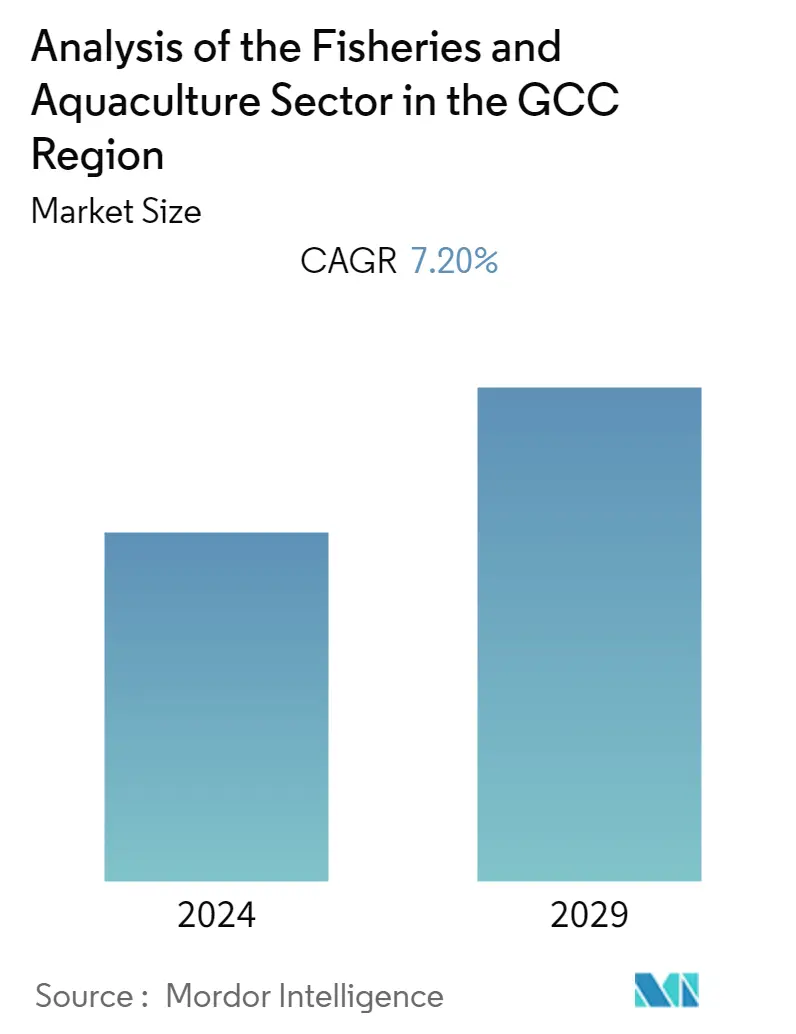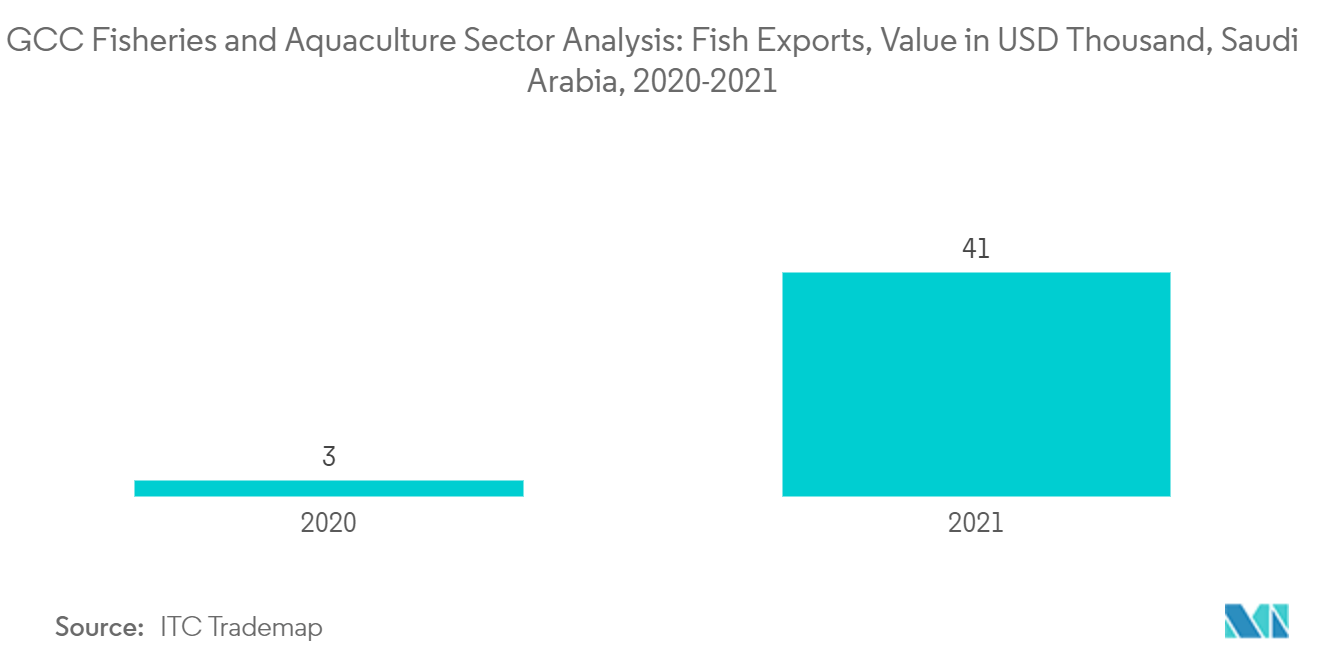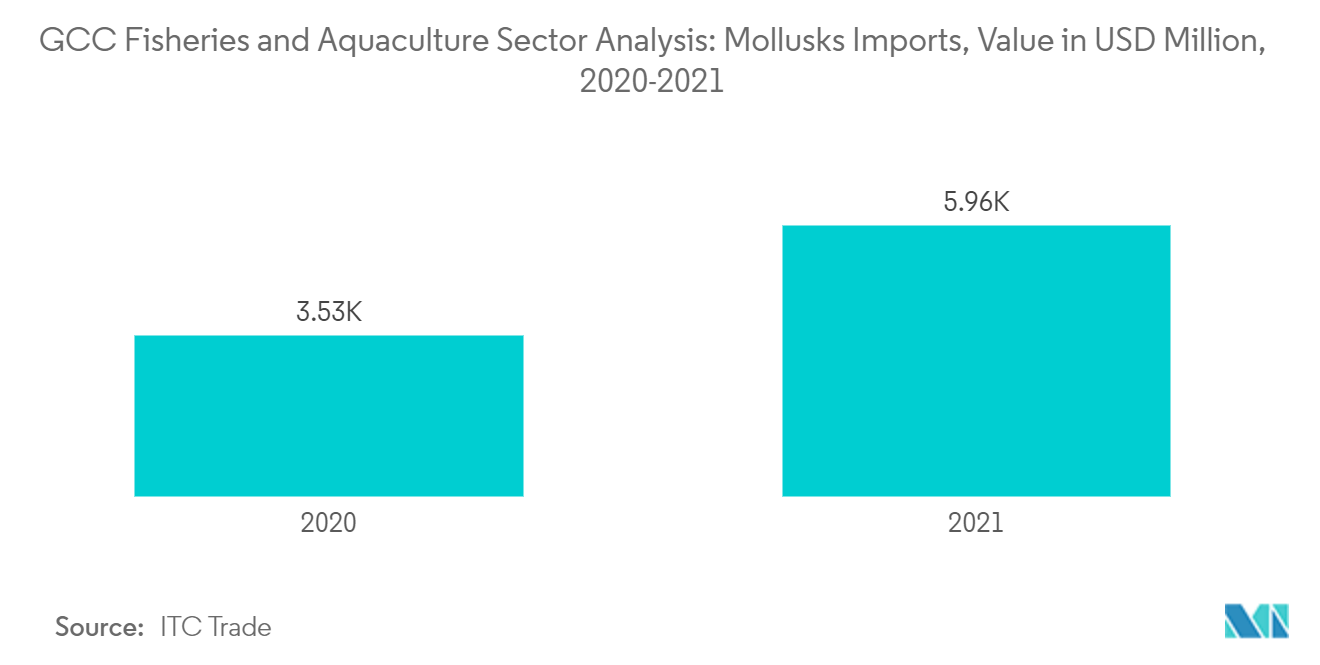GCC Fisheries and Aquaculture Market Size

| Study Period | 2019 - 2029 |
| Base Year For Estimation | 2023 |
| Forecast Data Period | 2024 - 2029 |
| Historical Data Period | 2019 - 2022 |
| CAGR | 7.20 % |
Major Players*Disclaimer: Major Players sorted in no particular order |
GCC Fisheries and Aquaculture Market Analysis
The GCC fisheries and aquaculture market is estimated to register a CAGR of 7.2% during the forecast period.
- The drivers identified in the market are a rapid rise in the population, an increase in affluent households, a focus on diversification, and changing diet preferences. The restraints identified in the market are unsustainable capture fishing patterns, a low level of informal fisheries consolidation, and a low level of knowledge and technology dissemination.
- According to the Ministry of Environment, Water & Agriculture (M EWA), the country's local seafood market is thriving, and Saudi Arabia's seafood consumption is expected to grow by 7.4% per annum until 2030.
- Population growth and increased consumption per capita will generate additional demand in the coming years. With a declining growth in capture fisheries and stricter safety regulations imposed on imports, aquaculture is set to be the main source of seafood supply for the Kingdom. This is expected to grow the market during the forecasting period.
- The MEWA has established strict regulations, such as the mandatory Global Aquaculture Alliance/Best Aquaculture Practices (GAA/BAP) certification. The country plans to be the first in the world to have a national-level BAP certification. This can help ensure environmentally safe and sustainable products. Furthermore, this will help in the safety and security of the country along with environmental issues and tends to grow the market in the coming years.
GCC Fisheries and Aquaculture Market Trends
This section covers the major market trends shaping the GCC Fisheries & Aquaculture Sector Market according to our research experts:
Government Initiatives for Sustainable Fish Farming
- The governments in the Gulf region have developed policies and favorable investment conditions to raise the level of fish farming in the region. The primary attributes of the development of the aquaculture sector in the region have been high import dependency, preservation of scarce freshwater, and potential for export surplus.
- Although the aquaculture industry is still in the burgeoning phase, Oman's Ministry of Agriculture and Fisheries has been making large-scale investments valued at USD 1.0 billion across 15,000 hectares of land for the development of the aquaculture sector. According to International Trade Center (ITC) Trademap, the import of fish in the country declined in 2021 by 62 million metric tons compared to the previous year due to the pandemic. The country is expected to produce 200,000 metric tons of fish between 2030 and 2040.
- The GCC aquaculture sector has seen a rise in local infrastructure projects in recent years due to the change in local fish consumption patterns, increasing local demand and new regional developments are also receiving public support.
- For instance, Saudi Arabia's megacity project Neom and Tabuk Fish Company signed an agreement to develop the Middle East and North Africa's (MENA) biggest fish farm as the Kingdom diversifies its economy. The agreement aims to expand local aquaculture production and apply the latest fish farming technologies in the futuristic Neom city. The capacity and innovative nature of the hatchery, combined with top-notch technologies, will help position Saudi Arabia at the forefront of sustainable marine aquaculture.
- Under Neom's new agreement with Tabuk Fish Company, the hatchery will operate with a capacity of 70 million fingerlings, making it the largest in the region. The hatchery will focus on improving the production of local fish species in the Red Sea to fulfill the Kingdom's goal of producing 600,000 tonnes of fish products by 2030.
- Moreover, the Saudi Ministry plays a crucial role in expanding the aquaculture sector to meet domestic demand and produce surplus fish for exports. According to World Bank, in 2020, the total fish production in Saudi Arabia reached 99,907 metric tons intending to surpass 600,000,0 metric tons in 2030. Therefore, the supportive government policies toward the objective of expanding the aquaculture industry are further expected to drive the market during the forecast period.

Increasing Consumption of Sea Food
- Due to their excellent nutritional value and low-fat protein food, the demand for fish and seafood is increasing among consumers. The rise in meat consumption, growing health concerns, changing diet patterns, urbanization, population, and economic growth are the factors influencing the higher preference towards seafood products.
- The United Arab Emirates (UAE) government is focusing on increasing aquaculture projects as it is a viable source for improving the region's food security which is the major concern in the country. Rapid growth and development and the diverse population of the UAE, coupled with the rising consumption of seafood, are likely to be the major factor that is driving the fisheries and aquaculture sector.
- The UAE has acquired food security through the availability of fresh fish. Some of the species preferred by the consumer are small pelagic fish, such as sardines and mackerel, and large pelagic fish, such as tuna. Also, grouper, emperor, tilapia, and pomfret are other species popular in the country.
- According to the Environment Agency - Abu Dhabi (EAD), in 2018, production in Abu Dhabi amounted to about 810 metric tons of aquatic organisms valued at approximately USD 5.06 million. Organic fish and seafood continued to grow in 2019, supported mainly by organic salmon.
- Westerners with high disposable incomes particularly seek organic variants when shopping for fish and seafood. The growing demand for high-protein diets is driving the demand for fish and seafood products to meet diet requirements. This trend is anticipated to rise exponentially, driving the fisheries and aquaculture market.

GCC Fisheries and Aquaculture Market News
- June 2022: The Ministry of Environment, Water, and Agriculture (MEWA) has decided to make the Kingdom of Saudi Arabia one of the first in the world in the aquaculture sector to be a member of the Network of Aquaculture Centres in Asia-Pacific (NACA).
- September 2021: OFC is expanding its presence at every stage of the fish value chain. To increase the volume of catch, it is expanding its own fleet of vessels and entering into strategic agreements with international vessel owners. It is also expanding its existing processing facilities and establishing a value-added products plant to significantly increase output from current levels.
- April 2021: NEOM, the Saudi megacity development project, signed an agreement with Tabuk Fish Company that includes plans for a fish farm with a production capacity of 70 million fingerlings. This would make it the biggest hatchery in the MENA region.
GCC Fisheries and Aquaculture Market Report - Table of Contents
1. INTRODUCTION
- 1.1 Study Assumptions and Market Definition
- 1.2 Scope of the Study
2. RESEARCH METHODOLOGY
3. EXECUTIVE SUMMARY
4. MARKET DYNAMICS
- 4.1 Market Overview
- 4.2 Market Drivers
- 4.3 Market Restraints
- 4.4 Value Chain Analysis
5. MARKET SEGMENTATION
-
5.1 Type
- 5.1.1 Pelagic Fish
- 5.1.1.1 Sardine
- 5.1.1.2 Mackerel
- 5.1.1.3 Tuna
- 5.1.1.4 Barracuda
- 5.1.2 Demersal Fish
- 5.1.2.1 Grouper
- 5.1.2.2 Trevally
- 5.1.2.3 Emperor
- 5.1.2.4 Pomfret
- 5.1.3 Freshwater Fish
- 5.1.3.1 Tilapia
- 5.1.4 Scallop
- 5.1.5 Lobster
- 5.1.6 Shrimp
- 5.1.7 Caviar
- 5.1.8 Other Types
-
5.2 Geography
- 5.2.1 Saudi Arabia
- 5.2.2 United Arab Emirates
- 5.2.3 Oman
- 5.2.4 Qatar
- 5.2.5 Bahrain
- 5.2.6 Kuwait
6. MARKET OPPORTUNITIES AND FUTURE TRENDS
** Subject To AvailablityGCC Fisheries and Aquaculture Industry Segmentation
Fisheries and aquaculture can be defined as raising and harvesting aquatic organisms, including wild marine and freshwater fish, for food or industrial purposes.
The fisheries and aquaculture sector in the GCC region is segmented by type (pelagic fish, demersal fish, freshwater fish, and scallop) and geography (Saudi Arabia, United Arab Emirates, Oman, Qatar, Bahrain, and Kuwait). The market includes production analysis (volume), consumption analysis (value and volume), export analysis (value and volume), import analysis (value and volume), and price trend analysis across the GCC.
The report offers market estimation and forecasts in value (USD million) for the above-mentioned segments.
| Type | Pelagic Fish | Sardine |
| Mackerel | ||
| Tuna | ||
| Barracuda | ||
| Type | Demersal Fish | Grouper |
| Trevally | ||
| Emperor | ||
| Pomfret | ||
| Type | Freshwater Fish | Tilapia |
| Type | Scallop | |
| Lobster | ||
| Shrimp | ||
| Caviar | ||
| Other Types | ||
| Geography | Saudi Arabia | |
| United Arab Emirates | ||
| Oman | ||
| Qatar | ||
| Bahrain | ||
| Kuwait |
GCC Fisheries and Aquaculture Market Research FAQs
What is the current GCC Region Fisheries and Aquaculture Market size?
The GCC Region Fisheries and Aquaculture Market is projected to register a CAGR of 7.20% during the forecast period (2024-2029)
What years does this GCC Region Fisheries and Aquaculture Market cover?
The report covers the GCC Region Fisheries and Aquaculture Market historical market size for years: 2019, 2020, 2021, 2022 and 2023. The report also forecasts the GCC Region Fisheries and Aquaculture Market size for years: 2024, 2025, 2026, 2027, 2028 and 2029.
GCC Aquaculture Industry Report
Statistics for the 2024 GCC Aquaculture market share, size and revenue growth rate, created by Mordor Intelligence™ Industry Reports. GCC Aquaculture analysis includes a market forecast outlook to 2029 and historical overview. Get a sample of this industry analysis as a free report PDF download.



